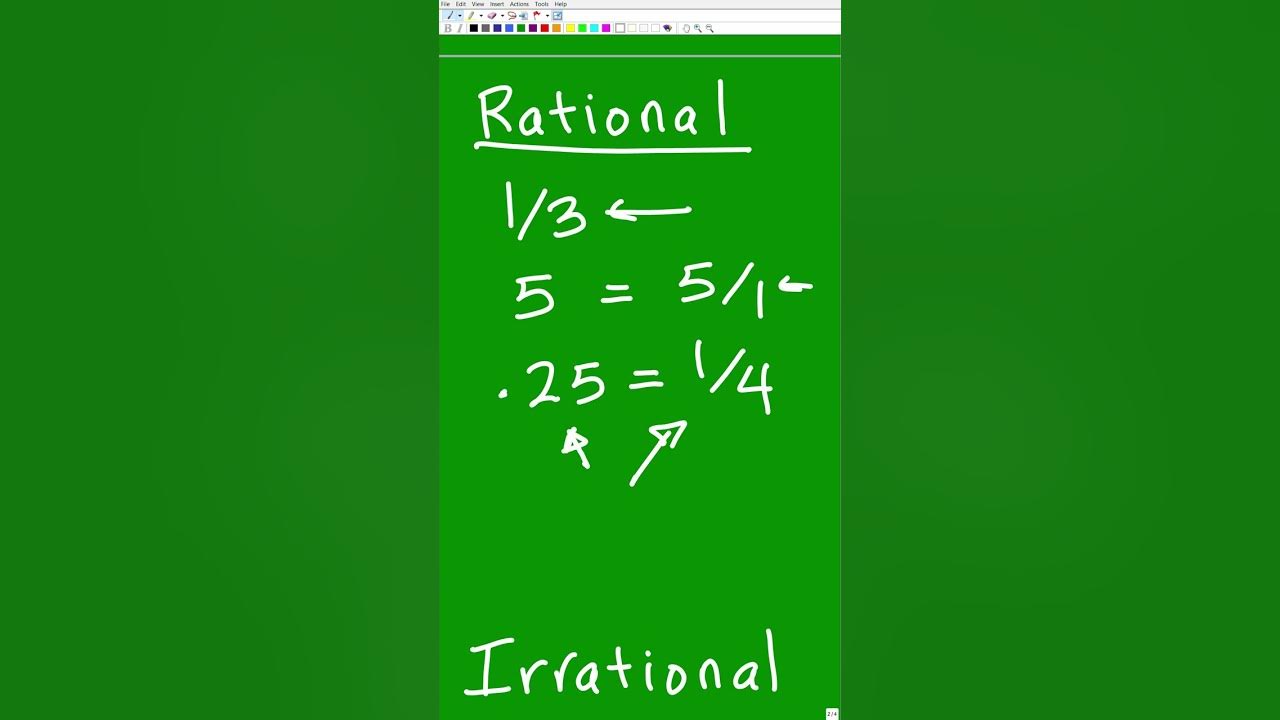Definition of irrational numbers
Irrational numbers are real numbers that cannot be expressed as a fraction or the ratio of two integers. They are numbers that cannot be written as terminating or repeating decimals. Irrational numbers are non-repeating and non-terminating decimals. Some examples of irrational numbers include the square root of 2 (√2), the square root of 3 (√3), and π (pi). These numbers can be expressed as decimals that go on forever without a pattern. Unlike rational numbers, which can be written as fractions, irrational numbers have infinite and non-repeating decimal expansions.
Properties of irrational numbers
1. Non-repetitive decimal representation: Irrational numbers cannot be expressed as a fraction and their decimal representation goes on forever without repeating. For example, the square root of 2 is an irrational number (approximately 1.41421356) and its decimal representation has no repeating pattern.
2. Non-terminating decimal: Irrational numbers have a decimal representation that does not terminate. Unlike rational numbers, which can have decimals that terminate after a certain number of digits, irrational numbers continue indefinitely. As a result, they cannot be expressed as a fraction of two integers.
3. Unbounded: The decimal representation of irrational numbers has no limit or bound. The digits keep on going forever without any pattern or recurring sequence. This property reflects their infinite nature.
4. Cannot be expressed as a ratio: As the name suggests, irrational numbers cannot be expressed as a ratio of two integers. They do not possess a simple fraction representation like rational numbers.
5. Exist between any two rational numbers: Between any two rational numbers, there exists an infinite number of irrational numbers. This means that the real number line is densely populated with irrational numbers, filling the gaps between rational numbers.
6. Transcendental: Some irrational numbers, known as transcendental numbers, are even more special. Transcendental irrational numbers are not the roots of any polynomial equation with integer coefficients. Famous examples include pi (π) and e, the base of the natural logarithm.
7. Algebraic and non-algebraic: Irrational numbers can be classified into two categories: algebraic and non-algebraic. Algebraic irrational numbers are roots of polynomial equations with integer coefficients. For example, the square root of 2 is an algebraic irrational number. Non-algebraic irrational numbers, such as transcendental numbers, cannot be expressed as roots of polynomial equations with integer coefficients.
These properties make irrational numbers intriguing and fascinating mathematical entities, contributing to the richness of mathematics and its applications in various fields.
Examples of irrational numbers
Here are some examples of irrational numbers:
1) π (pi): The ratio of a circle’s circumference to its diameter, approximately equal to 3.14159265359.
2) √2 (square root of 2): The length of the diagonal of a square with sides of length 1.
3) √3 (square root of 3): The length of the diagonal of a cube with sides of length 1.
4) √5 (square root of 5): The result of the Pythagorean theorem when the two legs are both of length 1.
5) e (Euler’s number): A mathematical constant approximately equal to 2.71828, used extensively in calculus and exponential functions.
6) √7 (square root of 7): Quite similar to other square roots examples, it represents the length of the diagonal of a square with sides of length 1.
7) φ (phi or the golden ratio): An irrational number approximately equal to 1.6180339887, often found in nature and art due to its aesthetic properties.
8) √10 (square root of 10): The square root of a non-perfect square, approximately equal to 3.16227766017.
These examples represent just a few of the countless irrational numbers that exist, as there are infinitely many irrational numbers between any two rational numbers.
Relationship between rational and irrational numbers
Rational numbers and irrational numbers are both types of real numbers, but they have distinct characteristics and properties.
Rational numbers can be expressed as the ratio of two integers, where the denominator is not zero. They can be represented as terminating decimals (e.g., 0.5, 2.75) or repeating decimals (e.g., 0.333…, 0.464646…). Rational numbers can also be written as fractions (e.g., 1/2, 3/4).
On the other hand, irrational numbers cannot be expressed as the ratio of two integers. They cannot be written as terminating or repeating decimals. Irrational numbers are non-repeating and non-terminating decimals that cannot be represented by fractions. Examples of irrational numbers include √2, π (pi), and e (Euler’s number).
One important relationship between rational and irrational numbers is that together they form the set of real numbers. This means that any number on the number line can be classified as either rational or irrational. Furthermore, between any two rational numbers, there exists an infinite number of irrational numbers.
Additionally, the sum or difference between a rational number and an irrational number is always irrational. For example, 3 + √2 is an irrational number. Similarly, the product or division of a non-zero rational number and an irrational number is also irrational. For instance, 2 * √3 is irrational.
In summary, while rational numbers are expressible as fractions or terminating/repeating decimals, irrational numbers cannot be represented in such forms and are non-repeating and non-terminating. They both collectively make up the set of real numbers, and their interactions often result in the creation of new irrational numbers.
Applications of irrational numbers in mathematics
Irrational numbers are numbers that cannot be expressed as the ratio of two integers (i.e., as a fraction) and have an infinite and non-repeating decimal representation. Despite their seemingly unpredictable nature, irrational numbers have various applications in mathematics. Here are a few examples:
1. The Pythagorean Theorem: One of the most famous applications of irrational numbers is in the Pythagorean theorem. In a right-angled triangle, the square of the hypotenuse is equal to the sum of the squares of the other two sides. However, in many cases, the lengths of the sides are not whole numbers, leading to the existence of irrational numbers. For instance, consider a right-angled triangle with side lengths 1 unit and 1 unit. By applying the theorem, the length of the hypotenuse is found to be √2, an irrational number.
2. Euclidean Geometry: The field of geometry extensively utilizes irrational numbers. For example, constructing a line segment with a length of √3 units using only a compass and a straightedge is impossible if only rational numbers are allowed. The existence of irrational numbers enables more intricate constructions and helps in solving geometric problems.
3. Mathematical Analysis: Irrational numbers play a crucial role in calculus and mathematical analysis. The notion of a limit, which is fundamental in these fields, often involves irrational numbers. For instance, the limit of a sequence or a function may converge to an irrational number. The study of continuity and derivatives also involves irrational numbers, as their values can be irrational for certain functions.
4. Number Theory: The study of irrational numbers intersects with number theory, where properties and relationships of numbers are explored. Irrational numbers serve as a rich source of examples in number theory, highlighting various patterns and properties that may not exist solely within the realm of rational numbers.
5. Fractals and Chaos Theory: Irrational numbers also find applications in fractals and chaos theory. These branches of mathematics deal with complex and often non-deterministic systems. Many fractal and chaos-based models use irrational numbers to generate intricate and self-similar patterns, as well as to depict chaotic behavior in systems.
In summary, irrational numbers play a significant role in various mathematical disciplines, including geometry, analysis, number theory, and even the study of complex systems. Their presence allows for the exploration of mathematical concepts beyond rational numbers and enables a deeper understanding of the natural world.
Topics related to Irrational numbers
Introduction to rational and irrational numbers | Algebra I | Khan Academy – YouTube
Introduction to rational and irrational numbers | Algebra I | Khan Academy – YouTube
Making sense of irrational numbers – Ganesh Pai – YouTube
Making sense of irrational numbers – Ganesh Pai – YouTube
Rational, Irrational and Real Numbers – YouTube
Rational, Irrational and Real Numbers – YouTube
Rational and Irrational Numbers – YouTube
Rational and Irrational Numbers – YouTube
Define Irrational Numbers #shorts – YouTube
Define Irrational Numbers #shorts – YouTube
Prove A Number Irrational in 5 Seconds 🔥 #shorts #ytshorts #maths #class10maths – YouTube
Prove A Number Irrational in 5 Seconds 🔥 #shorts #ytshorts #maths #class10maths – YouTube
Root Two is Irrational Visually – YouTube
Root Two is Irrational Visually – YouTube
Define Irrational Numbers. – YouTube
Define Irrational Numbers. – YouTube
what’s an irrational number? (short explanation) – YouTube
what’s an irrational number? (short explanation) – YouTube
How to find Irrational numbers between 2 numbers#fastcalculation – YouTube
How to find Irrational numbers between 2 numbers#fastcalculation – YouTube

Peter Scholze is a distinguished German mathematician born on December 11, 1987. Widely recognized for his profound contributions to arithmetic algebraic geometry, Scholze gained international acclaim for his work on perfectoid spaces. This innovative work has significantly impacted the field of mathematics, particularly in the study of arithmetic geometry. He is a leading figure in the mathematical community.











